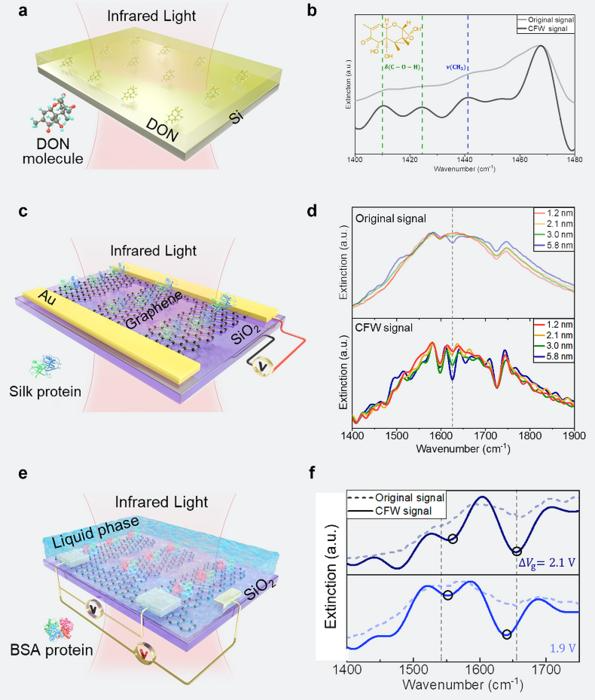Sensors are critical instruments for detecting and analyzing trace molecules in a wide range of applications, including environmental monitoring, food safety, and public health. However, finding sensors sensitive enough to detect these minute concentrations of molecules remains difficult.
 (a-b) Direct detection of multiple vibration modes. (c-d) The detection of silk protein molecular layer based on graphene-based SEIRA sensor; (e-f) The detection of BSA protein solution based on graphene-based SEIRA sensor. Image Credit: Kebo Zeng, Chenchen Wu, Xiangdong Guo, Fuxin Guan, Yu Duan, Lauren L Zhang, Xiaoxia Yang, Na Liu, Qing Dai and Shuang Zhang
(a-b) Direct detection of multiple vibration modes. (c-d) The detection of silk protein molecular layer based on graphene-based SEIRA sensor; (e-f) The detection of BSA protein solution based on graphene-based SEIRA sensor. Image Credit: Kebo Zeng, Chenchen Wu, Xiangdong Guo, Fuxin Guan, Yu Duan, Lauren L Zhang, Xiaoxia Yang, Na Liu, Qing Dai and Shuang Zhang
Surface-enhanced infrared absorption (SEIRA) is a promising technique that amplifies the infrared signals of molecules adsorbed on plasmonic nanostructures. Graphene’s excellent sensitivity and tunability make it a particularly suitable material for SEIRA. Nevertheless, intrinsic molecular damping reduces the strength of the graphene-molecule interaction.
In a recent study published in eLight, scientists from several different universities presented a novel strategy for raising SEIRA’s sensitivity. This method uses artificial complex-frequency waves (CFW) to at least ten-fold magnify chemical signals picked up by graphene-based sensors. It also holds for various stages of molecular sensing.
Thin films of Ag and Au were used to show SEIRA first. Nevertheless, plasmonic nanostructures with far higher biomolecule signal amplification capacities have been made possible by advances in nanofabrication and the creation of novel plasmonic materials.
Strong field confinement enabled by two-dimensional (2D) Dirac fermion electronic states allows graphene-based SEIRA to perform very well in molecular characterization for gas and solid phase sensing compared to metal-based SEIRA. In an aqueous solution, graphene can also improve molecular infrared absorption.
Graphene plasmons are noteworthy for their active tunability, which modifies the doping level by gate voltage, expanding the detection frequency range for various molecular vibrational modes. Graphene-based SEIRA is a special platform for molecular monolayer detection because of these benefits.
On the other hand, the interaction between plasmons and vibrational modes is significantly reduced by inherent molecular damping. Consequently, the spectra of plasmon-enhanced chemical signals become very wide and faint at very low concentrations, eventually being obscured by noise.
Adding optical gain materials is one method of mitigating the effects of molecular damping. Nevertheless, this calls for a sophisticated configuration that might not work with the detecting system. Gain materials also typically increase noise and instability.
Using complex-frequency waves (CFW) is a further option; theoretical research has demonstrated that the temporal attenuation of CFW can recover information lost due to material losses. Nevertheless, the problem of creating CFW in practical optical systems continues to be difficult.
The researchers suggest a novel technique for merging several real-frequency waves to create CFW. Superlenses’ spatial resolution has been effectively increased by the use of this technique.
The scientists show that adding synthetic CFWs to graphene-based SEIRA may significantly improve the molecular vibrational signatures. Applying synthesized CFWs to biomolecules under varying conditions, such as direct measurement of multiple vibrational modes of deoxynivalenol (DON) molecules and graphene-based SEIRA of proteins in both solid phase and aqueous solution, they successfully improve the molecular signals in the mid-IR extinction spectrum.
This novel method of SEIRA, which makes use of synthesized CFWs, could typically raise the detection sensitivity of conventional SEIRA technologies and is very scalable to other SEIRA technologies.
It might be used for the development of ultrasensitive sensors for a variety of uses, including fast toxin detection, tailored treatment, and early disease diagnosis. By making it possible to identify trace molecules that are now invisible, this method has the potential to completely transform the area of molecular sensing.
Journal Reference:
Zeng, K., et. al. (2023) Synthesized complex-frequency excitation for ultrasensitive molecular sensing. eLight. doi:10.1186/s43593-023-00058-y.